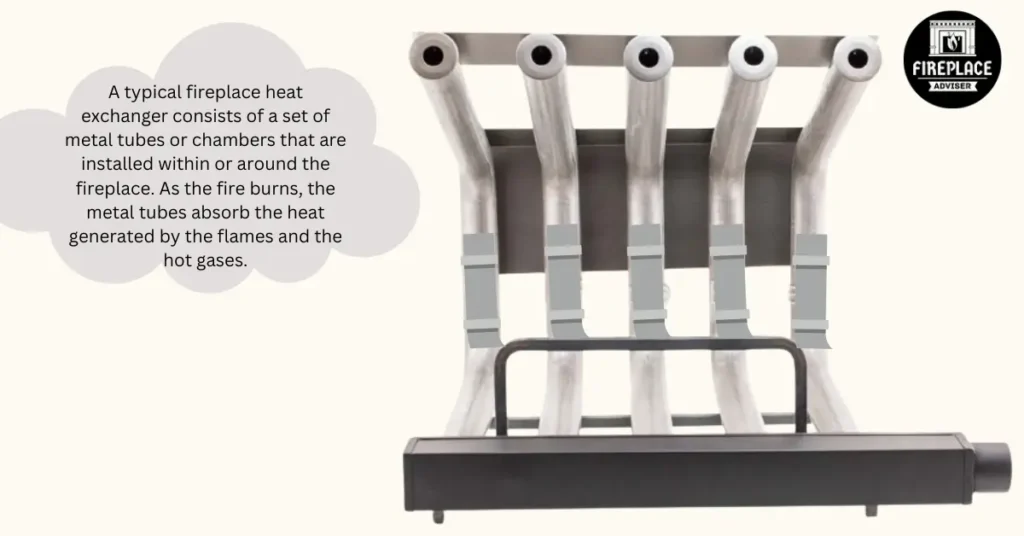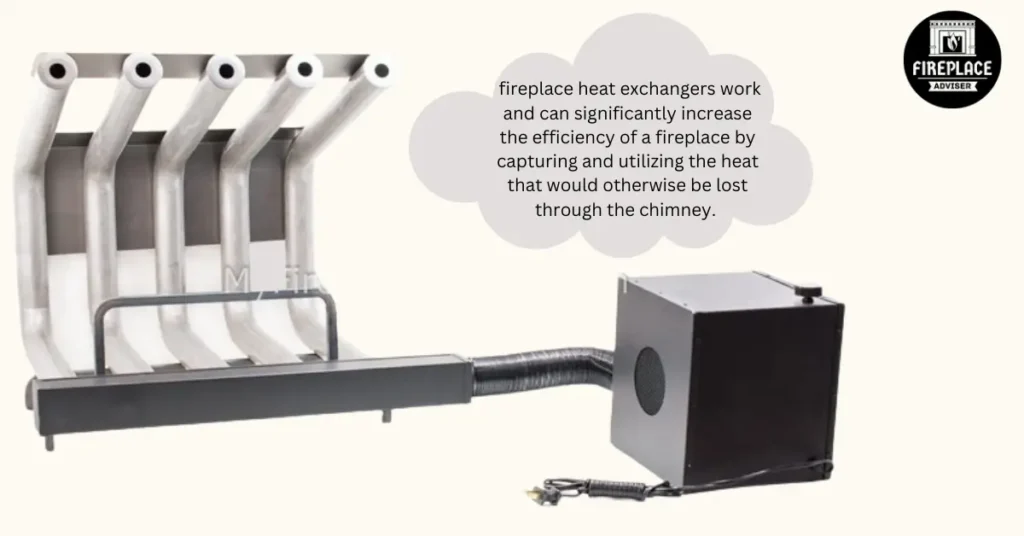Fireplaces have long been cherished for their ambiance and heat. However, as concerns about energy efficiency and environmental impact grow, homeowners seek ways to maximize the heat output of their fireplaces. One popular solution is the fireplace heat exchanger, a device designed to enhance the heating efficiency of traditional fireplaces. So, do Fireplace heat exchangers work?
Yes, fireplace heat exchangers do work and can be an effective way to improve the heating efficiency of your fireplace. A fireplace heat exchanger makes the most out of the available heat, it reduces the need for additional heating sources, leading to potential energy savings and lower utility bills.

In this article, we’ll delve into the mechanics of fireplace heat exchangers, exploring how they work, their benefits, and why they are becoming an increasingly popular choice for homeowners seeking to improve their fireplace’s performance.
What is Fireplace Heat Exchanger?
Fireplace heat exchanger is a device that increases the heat output of a wood-burning fireplace by capturing the excess heat that would otherwise escape through the chimney.
It works on a simple principle of heat transfer, where heat is exchanged from the hot flue gases to the surrounding air.
Do Fireplace Heat Exchangers Work?
Yes, fireplace heat exchangers work and can significantly increase the efficiency of a fireplace by capturing and utilizing the heat that would otherwise be lost through the chimney.
These devices are designed to extract heat from the hot flue gases produced during combustion and transfer it to the surrounding air, thereby effectively heating the room.
How Do Fireplace Heat Exchangers Work?
A fireplace heat exchanger operates by drawing in cool air, heating it using the hot air or gases produced by the fire, and then circulating the warmed air back into the room. This process enhances the heating efficiency of the fireplace, making better use of the heat generated by the fire.
Components
- Tubing or Coils: These are usually made of metal (such as steel or copper) and are placed within or around the firebox. The firebox is the main chamber where the fire burns.
- Blower or Fan: This component helps to move the air through the heat exchanger and out into the room.
- Inlet and Outlet Vents: These vents allow cool air to enter the heat exchanger and warm air to exit back into the living space.
Working Process
- Cool air from the room is drawn into the heat exchanger through the inlet vents, usually with the help of a blower or fan.
- The cool air passes through the metal tubing or coils that are heated by the fire. The metal absorbs the heat from the fire and transfers it to the air.
- The now-warmed air is pushed out through the outlet vents and back into the room, increasing the overall warmth.

Benefits of Using a Fireplace Heat Exchanger
- By capturing and recirculating wasted heat, a heat exchanger can significantly enhance the heating efficiency of a fireplace, leading to a warmer and more comfortable living space.
- As a fireplace heat exchanger makes the most out of the available heat, it reduces the need for additional heating sources, leading to potential energy savings and lower utility bills.
- With reduced heat wastage, a heat exchanger helps in lowering the overall environmental impact, as less fuel is consumed to maintain the desired indoor temperature.
- Fireplace heat exchangers promote better heat distribution throughout the room, eliminating cold spots and creating a more balanced and enjoyable environment.
Types of Fireplace Heat Exchangers
There are two main types of fireplace heat exchangers:
Grate Heat Exchangers
Grate heat exchangers are placed inside the fireplace, just above the fire. They usually consist of a metal grate with hollow tubes or channels through which air flows.
As the fire burns, the hot flue gases rise through the grate, and the air passing through the hollow tubes absorbs the heat from these gases. This heated air is then released into the room, providing additional warmth.
Tube-Type Heat Exchangers
These consist of a series of tubes placed within the firebox. Air is drawn through these tubes, heated by the fire, and then expelled back into the room.
Fireplace Insert Heat Exchangers
These heat exchangers are installed into the existing fireplace and are typically cast iron or steel. They have a sealed firebox with an insulated glass door.
The fireplace insert creates a closed combustion system, which increases the efficiency of burning wood or other fuels.
The heat exchanger in the insert absorbs heat from the combustion process and uses fans or natural convection to distribute warm air into the room.
Installation and Maintenance
Installing a fireplace heat exchanger is typically straightforward, but it’s essential to follow the manufacturer’s guidelines and, if necessary, seek professional assistance.
Proper maintenance, including regular cleaning and inspections, ensures the heat exchanger operates at peak efficiency.
Factors to Consider Before Installing a Fireplace Heat Exchanger
Before deciding on a fireplace heat exchanger, there are several factors to consider:
- The heat exchanger size should match your fireplace’s dimensions for optimal performance.
- Invest in a high-quality heat exchanger made from durable materials to ensure longevity and efficiency.
- Some fireplaces may not be suitable for heat exchanger installation, so check for compatibility before purchasing.
- Consider the design and appearance of the heat exchanger to ensure it complements your fireplace and interior decor.
You May Also Like To Read:
FAQs
Can a fireplace heat exchanger work with gas fireplaces?
Yes, fireplace heat exchangers are available for gas fireplaces, but they operate differently from those designed for wood-burning fireplaces. Make sure to choose the right type for your specific fireplace.
Are fireplace heat exchangers noisy?
Most fireplace heat exchangers operate quietly and do not produce any significant noise.
Final Thoughts: Do Fireplace Heat Exchangers Work?
In conclusion: Fireplace heat exchangers are a practical and efficient way to make the most of your wood-burning fireplace. These devices can substantially improve heating efficiency, save energy, and contribute to a cozier and more sustainable living space by harnessing and recirculating wasted heat.
Consider investing in a high-quality fireplace heat exchanger to elevate your fireplace experience and stay warm and comfortable during chilly winter nights.
Affiliate Disclosure: Fireplaceadviser.com is a participant in the Amazon Services LLC Associates Program. We may earn a commission when you click on certain links on this site and purchase.

Hello!! I am Jamal Khan. I often fix my home electric heaters and gas stove problems and research the common issues in the heating units to improve my knowledge and expertise. The aim of establishing fireplaceadviser.com is to share my expertise and knowledge with my audience.











